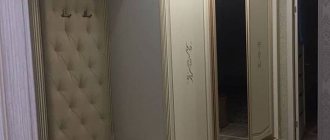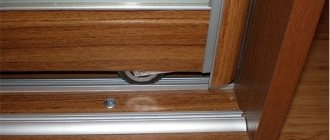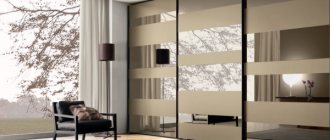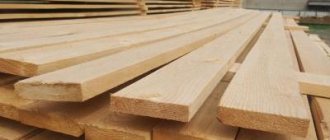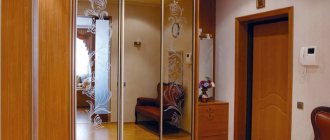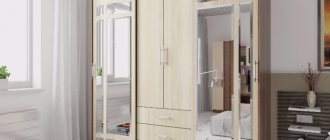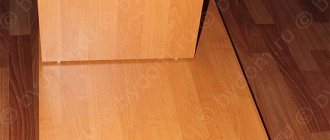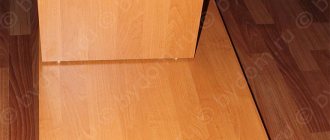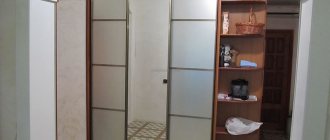Currently, many rural residents cannot afford to purchase new furniture for their home. And city apartments do not always have a large area where it would be possible to place household items. But, despite this, people still learned to cope with these problems on their own. To do this, you can make a wooden cabinet with your own hands, without the services of specialists. Carrying out such a design at home is not particularly difficult, but in order for the furniture to have a long service life, it is necessary to become familiar with the sequence and nuances of the work in advance.
What is needed for production
Today, the consumer market provides various wooden materials for the manufacture of household items. Therefore, before you begin to consider the question of how to make a cabinet yourself, you first need to decide what material it will be made from. According to experts, the best products for this work are:
- plywood - this multilayer material has high wear resistance and strength. In addition, due to its environmental friendliness, it is absolutely harmless to human health. Plywood is produced in solid slabs, which simplifies the process of assembling household items;
- chipboards - chipboard sheets are considered the most popular products for creating home furniture. This is due to the fact that they combine good quality at an affordable price. These products are resistant to changes in temperature and moisture, do not deform under the influence of an aggressive environment and are characterized by increased strength;
- solid wooden boards - the material from the boards is cut from different types of wood. They are produced in different sizes, certain types of processing and quality of carpentry. For the construction of furniture, boards from pine, birch and oak are mainly selected. These rocks are endowed with high strength and resistance to changes in temperature and humidity.
Installing household items from pine with your own hands is a labor-intensive process, since the rock is not hard enough. But if you choose this material, you can create an extravagant design in any room.
Wooden boards
Chipboard
Plywood
So, having considered the options for materials that will be needed to make furniture, it is also worth familiarizing yourself with the tools for performing the work. The manufacture of cabinets is carried out using the following equipment:
- hand saw for sawing wood;
- grinding machine for polishing the surface of wood;
- protractor, for measuring the angle of inclination;
- ruler or meter tape for measuring dimensions;
- wooden dowels, for fastening the product and filling;
- metal corners for fastening furniture structures;
- wood slab for making shelving;
- mastic for sealing the structure.
In addition, in order to revive a household item with the desired shade, you will need to purchase water-based acrylic paint.
Important Features for Cabinets
When making a cabinet, you need to pay attention to the following parameters:
- Furniture dimensions
- Room layout
- Internal arrangement of the module
- Doors - they can be made not only different in the way they open, but also in the choice of material
- The budget that will be allocated for the manufacture of the cabinet
- Interior features, room style
Nuances of work taking into account the type of structure
There are several ways to build a wooden cabinet with your own hands.
Hull
As you can see from the photo, cabinet furniture consists of several component elements, which is why it is also commonly called modular. The peculiarity of such a cabinet is that the owners can, at will, supplement it with various internal and external elements. Initially, the design of the product is developed so that all parts are combined with each other and the body. To build a building, you will need elements such as a roof, bottom, back and side walls. All these elements can be made in the form of removable straight shelves on which things will be placed. It will also be possible to additionally build a pull-out shoe cabinet.
Preparing grooves for fastening shelves
It is better to assemble the structure in a horizontal position
We attach the top bar last
Vertical faceplates
Built-in
A distinctive feature of the built-in wardrobe is that it can be made from scrap materials. The fact is that it is mainly installed in niches of the room or in places where it is not possible to place standard furniture. A solid frame is not required to build the cabinet. It may be missing one or more walls, which are replaced by the floor, ceiling or walls of the building. Filling elements, as a rule, can be made in the same way as for cabinet furniture. But having constructed such a cabinet with his own hands from scrap materials, the consumer must be prepared for the fact that, unlike a cabinet product, this furniture cannot be moved to another place.
The design of each cabinet requires not only the presence of a body and internal filling, but also a front part. The main element of the façade is the door.
When making a built-in wardrobe, it is important to correctly mark the space for future shelves
Shelves must be securely attached
Special logs are required to secure doors
Accessories
Furniture fittings for cabinets include:
- fastenings for shelves, hangers and mirrors;
- furniture hinges;
- roller and ball guides;
- handles and decorative fittings;
- thrust bearings and legs;
- retractable mechanisms.
Everything that is used for fastening to the wall (bolts, ties and other hardware), as well as for opening and closing doors and drawers, must be made of high-quality materials.
Door fastening
Today, the consumer market offers various systems for fastening furniture doors. Each element has its own specific purpose, which depends on how the cabinet is opened.
Swing
Hinged doors are the most common type of furniture design. It consists of a wooden canvas and fastening equipment. The number of panels for a cabinet depends on the number of internal sections. As a rule, if the cabinet has one common section, two doors will be required. If the furniture consists of one narrow and one wide section, three doors will be required. The doors are fastened to the side walls of the cabinet using the following hinges:
- detachable - such a mount is installed on the inside of the cabinet wall;
- universal - these products can be installed regardless of the sides of the cabinet. The hinges are attached simultaneously to the body and doors of the furniture.
After the hinges are attached to the product box, the doors are hung on them.
Hole preparation
Alignment and installation of hinges
Coupe
Compartment doors are a sliding system where, when the closet is opened, one door overlaps another. Installation of such a design requires certain knowledge and skills, so before installing a sliding wardrobe made of plywood with your own hands, you first need to familiarize yourself with the names of the components and their location.
The accessories set includes:
- special wheels for moving doors, installed in their upper and lower parts;
- upper hanging structure for guiding the canvases;
- a lower guide structure along which the door wheels will move in the grooves;
- cassettes for installing wooden panels;
- locks and closers for easy door opening.
This design is intended for cabinet furniture with a threshold. If a built-in wardrobe is installed, it will be possible not to install lower guide elements on the floor.
Cabinet dimensions
- Height – only built-in wardrobes are installed under the ceiling. The rest should be installed at least at a distance of 15-20 centimeters from it. If you leave the indent less, there will be installation problems. The cabinet is assembled lying down; with a smaller distance, its diagonal simply will not allow lifting and placing a ready-made module
- The depth of the cabinet shelves should be at least 55 centimeters. If there is a wardrobe, you need to add another 10 centimeters for the doors. There are also very narrow cabinets - 20-30 centimeters. They will have to be attached to the wall, otherwise they will not be able to stand under the load of things.
The photo of a homemade cabinet shows that the width depends only on the room, so there are no specific standards here
Particular attention should be paid to the cabinet for the balcony with your own hands. It is necessary to calculate all the dimensions correctly, because errors can lead to a complete rework of the furniture.
Markings and drawings
Before you make a cabinet out of lining with your own hands, you first need to mark its location in the room and draw up a design drawing. Such preliminary procedures will help you quickly assemble cabinet or built-in furniture.
In the cabinet layout diagrams, it is necessary to take into account its width and height. To do this, first use a tape measure to measure the intended installation location. When carrying out measuring work, it is important to consider the distance from baseboards, window sills, pipelines and connectors for connecting electrical appliances. If you lose sight of these points, the wooden cabinet may not fit into the allotted space, or in the future there may be obstacles when opening doors or accessing the power source.
For a DIY cabinet, the drawings can be created using an automated CAD program or by hand. In the first case, the cabinet diagram is drawn up by a special computer system; in the second option, cabinet drawings are made with your own hands. As practice has shown, the second option is simpler, so it is chosen more often. To create a drawing by hand, you will need a sheet of paper and a pencil. Next, sketches of the cabinet are drawn on the sheet.
Description of drawing up a drawing of a wooden product:
- front view of the cabinet - this sketch includes the width and height of the furniture, the height of the base, the size of the sections, the distance of the shelves from each other. When drawing up a drawing, it is important to take into account the thickness of the furniture walls and its contents. You also need to indicate the attachment points for shelves and doors;
- top and side views - in this case, the depth of furniture and shelves is marked on a sheet of paper. When applying filling depth values, it is important to take into account the fastening of the doors. To ensure that the shelves do not interfere with the installation of fastening equipment, they should be located at a distance of 10 cm from the edge of the furniture’s front wall. Also in this sketch you need to indicate the rounding of the shelves with a radius of R.
In addition to the indicated values of the furniture body, you need to draw the dimensions of the filling elements on a sheet of paper. Shelves can be made in different configurations and thicknesses, but they must be of the appropriate size.
Stage 3: cutting
You can contact any company that deals with cutting with the dimensions and quantities of all parts. It is better to take laminated chipboard with emission class E1 or E0.5 - this is the most environmentally friendly option (manufacturers Egger, Kronospan). The cutting time, depending on the chosen material and furniture design, is 3-5 days.
The total cost of materials is 14,000 rubles. In stores you can find ready-made options at a slightly more expensive price, but they will be of worse quality than laminated chipboard and will not occupy the entire height of the room. If you order the same cabinet from furniture makers, they ask for at least 40,000 rubles for it. Maybe in your city the prices will be different.
It is worth separately agreeing on the marking of the holes for the hinge. Otherwise, you will have to make the “additive” yourself and buy a special drill.
Manufacturing of parts
Having made a drawing of the cabinet design with your own hands and prepared the appropriate equipment, you can begin to manufacture its parts. To do this, transfer the dimensions of the furniture elements onto a sheet of chipboard using a meter and pencil:
- upper part of the cabinet in quantity – 1 piece;
- side walls in quantity - 2 pcs;
- bottom in quantity - 1 piece;
- back wall in quantity – 1 piece;
- furniture shelves in the amount of individual consumer preference.
Next, using a saw along the marked lines, they begin to cut out the parts step by step. When performing these works, it is necessary to take into account the thickness of the saw itself, otherwise the furniture elements will be smaller after sawing.
After the parts are ready, they must be covered with melamine film. To do this, a film is applied to the structural elements, which is then ironed. After the cladding has set on the parts, all its excess remains are cut off with a stationery knife.
Preparing parts
Edge fastening
What hand tools will you need?
It all depends on what you decide to do yourself and what to delegate.
- Cutting parts. To cut chipboard and align the ends for gluing the edges, you will need a jigsaw with a wood file, a sander or router, sandpaper, a tape measure, a metal ruler and a pencil.
- Edging. The melamine edge is glued on with an iron, the excess is cut off with a stationery knife and sanded off with sandpaper. It is difficult to glue PVC edges at home; you will need special glue and a router.
- Drilling parts . Before assembly, the workpieces are drilled for fasteners using a drill or hammer drill. You will need drills with a diameter of 5.7 mm, a confirmation drill. And also drills 10, 15, 20 mm, if eccentrics (minifixes) are used, 26/35 mm for installing hinges on swing doors. Thin awl for marking.
- Assembly. A screwdriver with Phillips and hex bits, a screwdriver or a ratchet for tightening fasteners in tight spaces.
- Auxiliary tool . The most common one, available to any craftsman: a set of screwdrivers and wrenches, a vice, pliers, wire cutters, a chisel, a hacksaw, a shoe knife, a square, a marker, a sharpener.
Assembly
It is better to assemble the cabinet at its intended location. In this case, it will be possible to prevent deformation of the walls and floor of the room when moving finished furniture. Initially, sheets of cardboard are laid on the intended floor, on which the structure of the product will be sequentially assembled.
Step-by-step instructions for assembling the cabinet, carried out in stages:
- the first side sheet is located on the floor;
- fasteners are fixed vertically to connect the bottom and top sides of the cabinet;
- the top and bottom of the furniture are installed and fixed on the sides;
- the second side sheet of the cabinet is placed on top and secured;
- the strength of fastening elements is checked;
- the cabinet is turned over with the front side on the floor;
- the back of the furniture is laid and secured;
- The cabinet rises and is installed tightly against the wall in the designated area.
Next, using a level, you need to create a level position for the cabinet, then fasten the doors, as well as install the filling.
So, having learned how to make a cabinet with your own hands, many beginners will not make serious mistakes when designing the structure. A step-by-step manufacturing guide will help you correctly complete the furniture parts. And if the given assembly sequence is followed, wooden cabinets will be able to stand for decades without deformation.
Classification by valves
Types of cabinet doors are:
Sliding on a rigid device
According to the subtypes of door movement, there are products with a roller mechanism, as well as on almost invisible monorails. Furniture supermarkets are filled with such luxuriously designed cabinets.
The interior ranges from super-finished wood or plastic to mirrored display cases. Cabinets with such doors are placed in small rooms, in which mirrors visually expand the area.
Hinged doors are a classic for any wardrobes or bedside tables
There is almost no need to repair them, just lubricate the awnings so that they do not creak. Even the most modern awnings, impregnated with graphite super-lubricant, will still creak at some point.
Lifting door leaves
Most often these are wall cabinets. Their disadvantage is the low-quality fittings that move the door. A year of work - and buy new movers.
